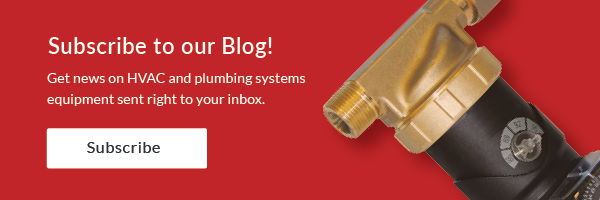|
Frequently Asked Questions Page 2 6. Q: Can I use a bladder tank and a steel compression tank in the same system? A: Yes you can, but I would exhaust options to keep them the same type first. If you mix the styles of tanks, they must be connected properly for the tank type and connected very close together (within a few feet). As an example, a compression tank is mounted properly above the Rolairtrol air separator and you add a bladder tank attached to the main pipe between the Rolairtrol and system circulating pump. You would size the added tank based on the additional volume. Be careful if you change the fill or maximum pressures since the existing tank would have to be re-sized for the new conditions. 7. Q: Adding on to my system, need to increase my compression tank/expansion tank capacity, How do I put another tank in parallel with the existing, or my existing tank is too small, how do I increase capacity? A: Let’s start with compression tanks. When adding a steel compression tank next to the existing steel compression tank, make sure the tops of the tanks are at the same level to insure air is at the same level. If the tanks are the same size, then the bottoms of the tank will line up also, making it easy to install. Also, insure pipe pitch is maintained with no drops before going to the tank or you will cause a trap which will keep air from rising to the tank. Ask your B&G sales rep for a copy of the Air Management TEH manual for more details. Bladder tanks should be mounted with the bottom of the tank at the same level since we are not interested in air moving in and out of the tank. 8. Q: What happens if the bladder type tank air charge is not increased to the proper fill pressure? A: The engineer may be blamed for under sizing the tank even though they didn’t. Let me explain with an example. Let’s assume a tank needed a volume of 200 gallons with a fill pressure or starting pressure of 50 PSIG. Let’s assume the installing contractor left the tank with the 12 PSIG fill before connecting the system to the tank. When the 50 PSIG fill pressure in the system is attached to the tank, the tank will partially fill with water until the air side matches the water side at 50 PSIG. If someone checks the air side pressure, it will read 50 PSIG and the assumption is that it was pre-charged. In reality, you now have less than 100% of the tank available to limit the pressure in the system and it will act like an undersized tank. The pressure relief valve may blow before getting to the design temperature. The only way to check the air charge in a system is to drain the water and the system pressure out of the tank and then check the air pressure! This concludes the expansion and compression tank Monday Morning Minutes series. Next week we begin a new series on Steam Humidification Systems. |
Disclaimer: R. L. Deppmann and it’s affiliates can not be held liable for issues caused by use of the information on this page. While the information comes from many years of experience and can be a valuable tool, it may not take into account special circumstances in your system and we therefore can not take responsibility for actions that result from this information. Please feel free to contact us if you do have any questions.

